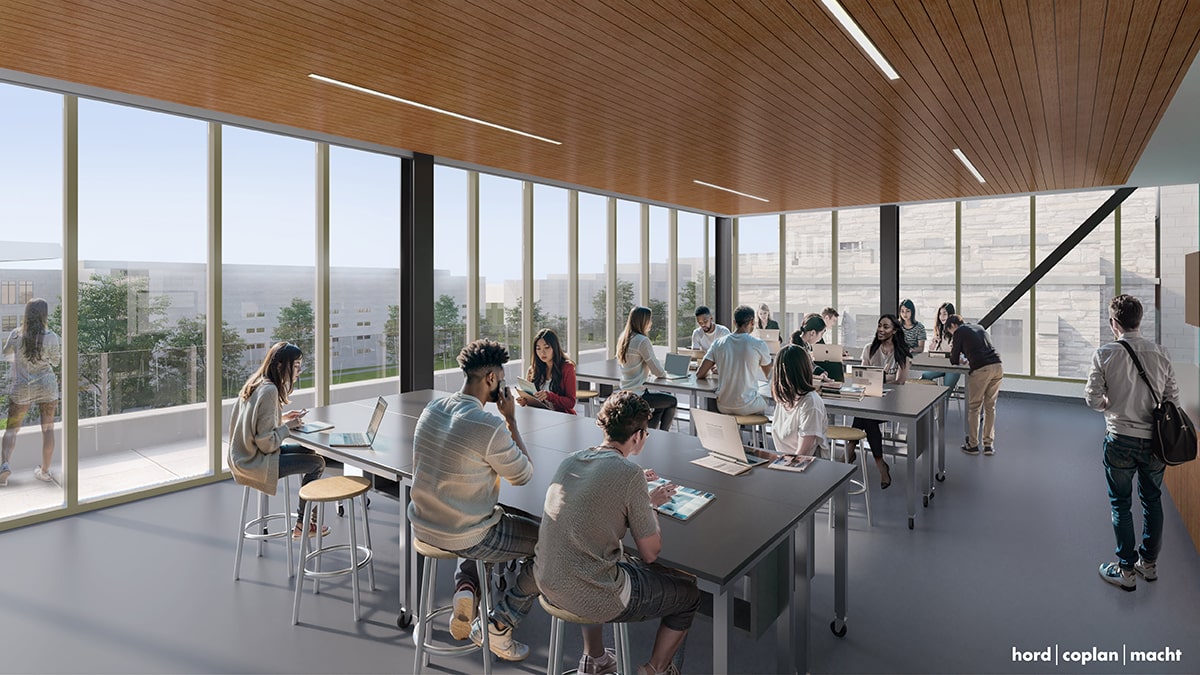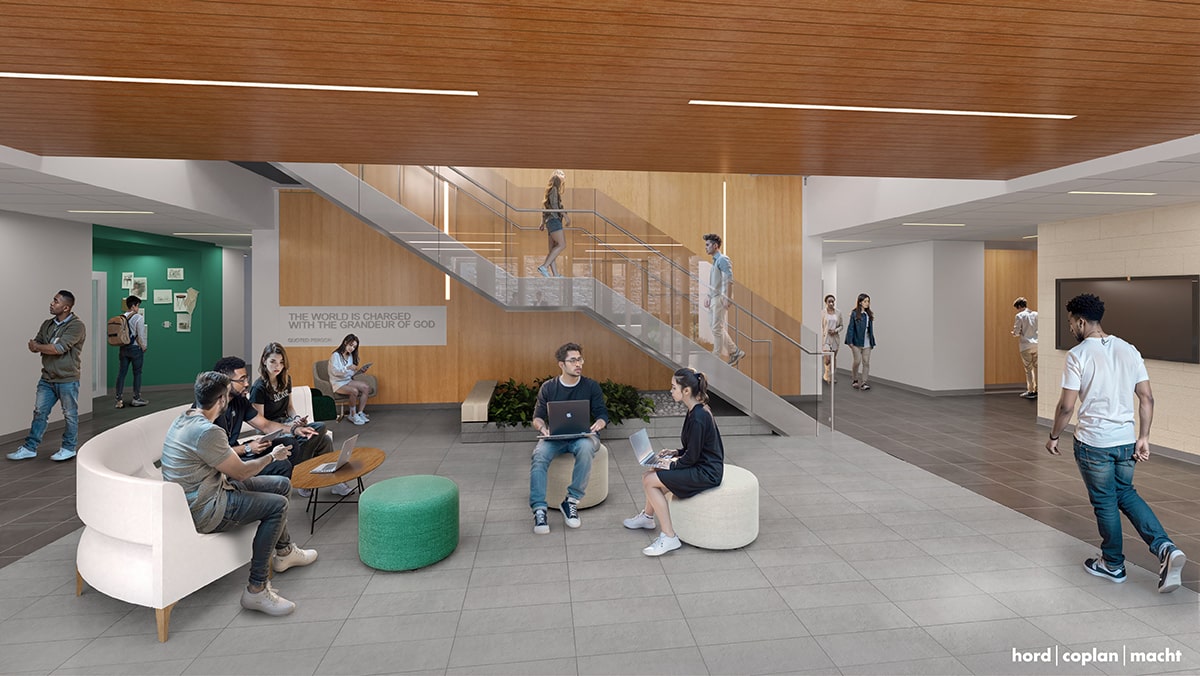Let's Grow STEM
Loyola launches addition and enhancement of Donnelly Science Center
Since Miller Gruen, ’27, started at Loyola last fall, the physics major has discovered that the University offers many opportunities to students studying STEM (science, technology, engineering, and mathematics).
“In my journey, I have felt extremely supported,” said Gruen, a physics major from Glen Arm, Maryland. “I am thoroughly enjoying my studies here.”
When Gruen realized that Loyola was starting a construction project to expand and enhance Donnelly Science Center, he started imagining what it will be like to be a student in the new addition and the enhanced building, which has been home to Loyola’s science programs for more than 45 years.
“I’m excited to research and study in renovated lab space with current technology,” said Gruen, who was selected as one of Loyola’s 2024 Hauber Summer Research Fellows. “Updated technology is important for preparing students for a successful professional career in STEM.”
The Rise of STEM
We expect this transformation of Donnelly Science Center to promote our vibrant culture of scientific exploration, innovation, and intellectual inquiry.
Loyola has a long, rich history of excellence in STEM with generations of faculty scholars and outstanding alumni who have contributed to the fields. Now, as the University embarks on its new strategic plan, Together We Rise: Loyola University Maryland’s Strategic Plan for 2030, Loyola is investing in STEM programs— including a two-year renovation and construction project of Donnelly.
“We expect this transformation of Donnelly Science Center to promote our vibrant culture of scientific exploration, innovation, and intellectual inquiry,” said Cheryl Moore-Thomas, Ph.D., provost and vice president for academic affairs. “The architecture of the building not only offers more space for learning, scholarship, and research, but will also allow for even greater collaboration among our faculty and current and future students.”
An 18,000-square-foot addition to the Donnelly Science Center, designed by Baltimore architect Hord Coplan Macht, aims to bring openness to the building and highlight science happenings through interactive spaces. Whiting Turner is the contractor for the construction, which started this summer and is scheduled to be completed by fall 2026.
The expansion and improvements to Donnelly will offer the perfect setting for the University’s new Bachelor of Science in Nursing (BSN) program, which will launch in fall 2025. The first cohorts in the program will learn in newer, interactive spaces.
“Although the full renovation will not be complete at the launch of the program, it will be exciting to have nursing students experience new classrooms and laboratories as they progress. They will have many opportunities for hands-on, skills-based learning,” said Maiju Lehmijoki Wetzel, Ph.D., BSN, R.N., director of Pre-Health programs.

Growth in the Sciences
Over the past decade, Loyola’s science programs have experienced substantial growth—nearly doubling the number of science majors. In addition to the number of students entering science-related majors, the University has created several new programs including Data Science, Forensic Science, Forensic Pattern Analysis, Biological Forensics, and Biohealth, which have attracted undergraduate and graduate students.
The combination of talented students, dedicated faculty and staff, and modern science facilities creates a strong foundation for Loyola University Maryland to lead in the sciences.
“The combination of talented students, dedicated faculty and staff, and modern science facilities creates a strong foundation for Loyola University Maryland to lead in the sciences,” said Bahram Roughani, Ph.D., associate dean for natural and applied sciences. “To sustain and enhance our thriving science program and solidify Loyola’s reputation in liberal arts, Jesuit, and STEM education, we must provide a state-of-the-art science facility that matches the dedication of our highly qualified faculty.”
Building Beginnings & Renovation Details
The Donnelly Science Center, which opened in 1978, is located on Loyola’s Evergreen campus at the intersection of Charles Street and Cold Spring Lane. The building has undergone significant renovations twice—in 1999 and in 2011. Those projects included an expansion of new laboratory spaces, the addition of a microscopy center, and new spaces for the departments of biology, chemistry, physics, computer science, and engineering.
“Since the building’s opening, the Donnelly Science Center has been a staple for students to learn alongside prestigious faculty in the sciences,” Roughani said. “We are excited to have new space to support and include all students in faculty research projects and support the University’s efforts around high-impact teaching practices.”
The building’s addition will be on the east end of the Donnelly Science Center, giving the sciences a more prominent, visible presence on the Quad. This project will include six large, modern teaching laboratories, new space for faculty research, office spaces, and common areas for students to gather and study.
The interior design of the project will align with Loyola’s brand and include vibrant green, grey, and black color schemes with corridor-side windows to allow views into lab and classroom spaces. Exterior landscaping will include native plantings, a grove of trees, and an outdoor classroom as well as a new main entrance to the building.

Upgrades to the heating, ventilation and air conditioning, and electrical systems will help bring the building infrastructure up to date and provide thermal comfort year-round and increase energy efficiency.
As part of Loyola’s commitment to sustainability, the renovations and addition will strive to achieve a global standard for sustainable buildings—the Leadership in Energy and Environmental Design (LEED) Gold certification. The Miguel B. Fernandez Family Center for Innovation and Collaborative Learning, which opened in 2021, is the only other building on campus to receive LEED certification.
“This is an aggressive goal given the energy intensity of the building and its technical complexity,” said Meredith Sullivan, Loyola’s director of project management. “The bulk of the LEED credits will come from a complete replacement of the building’s mechanical systems. Not only will they be more efficient, but the improved systems will minimize the amount of hood fume exhaust by 46% and increase air flow.”
Philanthropic Support
The building renovation and new addition will cost $78 million and will be supported by a $5.25 million grant from the State of Maryland. There are also opportunities for donors to name renovated spaces—including parts of the addition, laboratory spaces, engineering design space, maker space, and teaching laboratories.
“The expansion and improvements to the Donnelly Science Center provides many opportunities for our alumni and Loyola community to make history through their generous gifts,” said Mary Mazzuca Lineburger, ’99, assistant vice president of major gifts. “Our team is excited to lead the charge in securing funds for this project to support our ongoing, rapid growth in sciences at Loyola.”
The Future Is Bright
The Donnelly construction project marks the beginning of new opportunities in science exploration and expansion at Loyola, explained Roughani.
“Our faculty are actively developing additional science-based programs to meet student needs, such as those related to environmental sciences,” he said. “The continued growth of health and STEM programs at Loyola is greatly supported by modern science facilities, and the renovation and expansion of the Donnelly Science Center is a significant step forward in these efforts.”
Having a fresh new space in the future for STEM will help solidify Loyola as a place where students can receive high-quality education in science-related programs and across the liberal arts.
Elizabeth Dahl, Ph.D., director of the environmental studies minor and associate professor of chemistry, has been instrumental in the University’s expansion of its environmental science offerings. She believes the new space— and the dedication of faculty, staff, and administrators to advance and develop new program offerings and opportunities for students—will draw even more students to study at Loyola.
"Having a fresh new space in the future for STEM will help solidify Loyola as a place where students can receive high-quality education in science-related programs and across the liberal arts,” she said. “The new building improvements should allow for more student collaboration. There may also be additional incentives for faculty to engage in research with students, since each faculty member will have dedicated research space—and we will have more space for students to work.”
In addition to the increase in the number of students studying STEM at Loyola and the exciting new renovations and addition to the Donnelly Science Center, Roughani hopes this project will ignite the Loyola community in excitement for the future of science programs at Loyola.
“The renovated spaces will transform the existing teaching and research labs into state-of-the-art 21st-century facilities, significantly improving the building’s flow and consolidating departmental offices in a more organized manner,” he said. “This new, expanded science facility stands as a testament to our commitment to excellence. We hope it will instill pride in our students, our faculty, and our alumni, providing them with yet another reason to champion and support our University and its science programs.”
Learn more about making a gift to the Donnelly Science Center project.